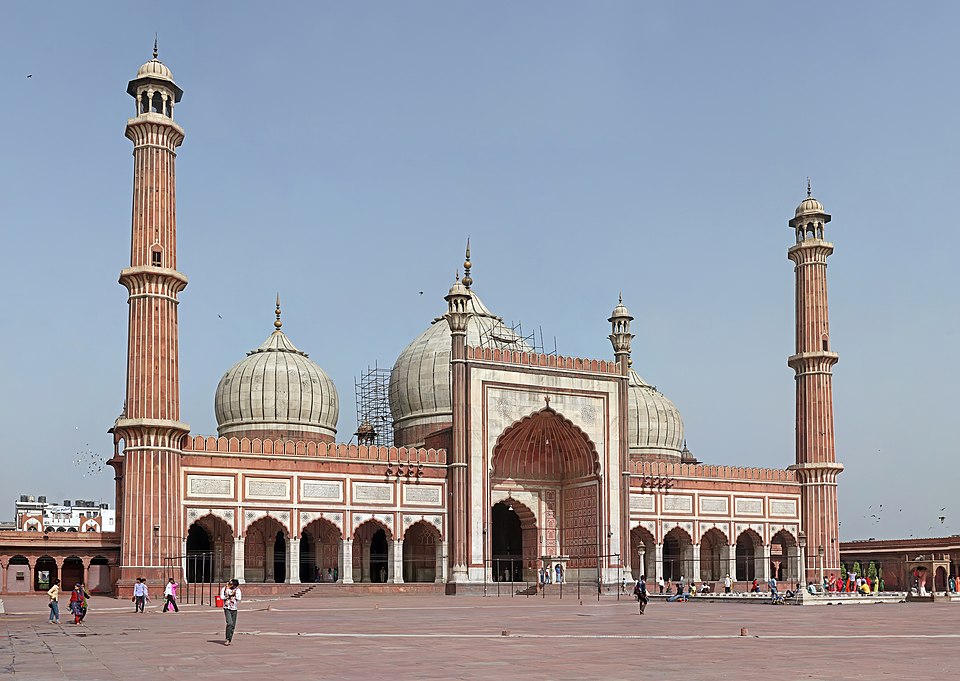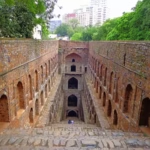Nestled in the vibrant heart of Old Delhi, Jama Masjid is not just a mosque—it’s a living, breathing embodiment of India’s Mughal heritage. Built by Emperor Shah Jahan, the same visionary behind the Taj Mahal, Jama Masjid has stood the test of time as a majestic symbol of Islamic faith, communal harmony, and awe-inspiring architecture.
Whether you’re a history buff, a spiritual seeker, or an explorer chasing the soul of Delhi, Jama Masjid is a chapter of India’s story you can walk through—barefoot, beneath the open sky.
The Origin of Grandeur: A Mughal Masterpiece
Commissioned in 1650 and completed in 1656, Jama Masjid was constructed by over 5,000 artisans under the direction of Ustad Khalil, a prominent architect of the Mughal era. With a cost of ₹10 lakh—a staggering amount in the 17th century—it became one of the largest mosques in India and remains so even today.
Key Architectural Features:
- Red sandstone and white marble exterior
- Three grand gates, with the eastern gate reserved exclusively for the emperor
- Two 40-meter-high minarets offering a panoramic view of Delhi
- Four towers and three domes, perfectly aligned with Islamic architectural principles
- A vast courtyard that can hold over 25,000 worshippers
This architectural marvel reflects a harmonious blend of Persian, Islamic, and Indian design elements—each arch, minaret, and calligraphic detail tells a story of devotion and craftsmanship.
Beyond Bricks: The Spiritual Heartbeat of Old Delhi
The name ‘Masjid-i-Jahan-Numa’ means “World-Reflecting Mosque.” And rightly so, because it doesn’t just serve the religious needs of the faithful; it reflects the unity in diversity that is India.
What Makes Jama Masjid Spiritually Special?
- Daily prayers and Friday congregations bring together thousands in spiritual communion.
- During Ramzan, the mosque transforms into a hub of vibrant activity—devotees breaking fasts, children playing in the courtyard, and food stalls offering Iftar delicacies like seviyan, haleem, and biryani just outside its gates.
- The relics preserved here include:
- A hair of Prophet Muhammad (PBUH)
- His sandals
- An ancient Quran written on deerskin
For many, Jama Masjid is more than a place of worship—it’s an emotional connection, a generational legacy passed down through shared moments of prayer and peace.
A View from the Top: Experiencing the Minaret
Climb the 121 steps of the southern minaret, and you’re rewarded with a sweeping view of Old Delhi—Chandni Chowk’s chaos, Red Fort’s might, and the sprawl of heritage meeting modernity.
It’s not just a physical ascent but a metaphorical one—rising above the noise into a space of reflection and perspective.
Jama Masjid vs. Other Iconic Mosques: A Quick Comparison
| Feature | Jama Masjid, Delhi | Mecca Masjid, Hyderabad | Taj-ul-Masajid, Bhopal |
|---|---|---|---|
| Built By | Shah Jahan (1656) | Muhammad Quli Qutb Shah | Begum Shah Jahan |
| Capacity | ~25,000 | ~10,000 | ~175,000 |
| Architectural Style | Indo-Islamic Mughal | Qutb Shahi | Indo-Islamic + Modern |
| Special Features | Minaret climb, relics | Granite courtyard | Massive prayer hall & lake |
| Location Significance | Center of Old Delhi | Near Charminar | Heart of Bhopal |
Cultural Fabric: Jama Masjid in Today’s Delhi
Unlike some historical sites frozen in time, Jama Masjid remains an active center of faith and culture. Step into the courtyard, and you’ll witness:
- Children learning Quranic verses
- Tourists clicking selfies, marveling at the symmetry
- Locals sitting under the arches, seeking shade and serenity
- Vendors selling kebabs, attars, and prayer mats just outside
This coexistence of the sacred and the everyday makes Jama Masjid a rare kind of monument—not a relic, but a living part of the city’s identity.
Personal Reflection:
“The first time I stepped inside Jama Masjid, I felt small—not in a diminished way, but in a spiritual sense. As the call to prayer echoed through the courtyard, I felt deeply connected—not just to history, but to humanity.”
Tips for Visitors
🕌 Entry Timing:
Open daily from 7:00 AM – 12:00 PM and 1:30 PM – 6:30 PM
(Closed during prayer hours for non-Muslim visitors)
🩴 Dress Code:
Wear modest clothes; robes are available at the gate. Remove shoes before entering the mosque.
📸 Photography:
Allowed in most areas. A small fee is charged for using cameras.
🏞️ Minaret Climb:
Highly recommended for a 360° view of Old Delhi, especially around sunset.
Sustainability and Preservation: The Challenges Ahead
Being one of the oldest and most frequented monuments, Jama Masjid faces:
- Air pollution damage due to Delhi’s urban sprawl
- Neglected conservation efforts and unauthorized encroachments
- Over-tourism and lack of visitor awareness
Efforts by organizations like INTACH and the Archaeological Survey of India (ASI) are underway, but they require community participation and policy-level support to sustain this heritage.
Connecting Jama Masjid to the Soul of Delhi
You can’t explore Delhi without encountering its contrasts—the ancient and the modern, the sacred and the chaotic. Jama Masjid is the perfect microcosm of these contrasts.
It stands proudly near Chandni Chowk’s culinary chaos, the majestic Red Fort, and Dariba Kalan’s silver lanes—making it a must-visit on your Delhi itinerary.
This iconic mosque is a gateway to understanding Delhi’s layered identity—faith, resilience, art, and pluralism.
Final Thoughts: Why Jama Masjid Still Matters
More than 350 years since its construction, Jama Masjid continues to be:
- A spiritual anchor for thousands
- A cultural landmark defining Delhi’s skyline
- A testament to Mughal engineering and aesthetic vision
At a time when modern India is moving fast, Jama Masjid reminds us to pause, reflect, and reconnect—with history, faith, and one another.
🕌 Ready to Explore Jama Masjid?
Don’t just read about it—experience it.
📍Plan your visit, climb the minaret, explore Chandni Chowk, and taste the city’s soul through the spice, sound, and serenity of this sacred space.
🔗 Related Posts You May Like:
- Red Fort: The Citadel of Mughal Majesty
- Chandni Chowk Food Trail: A Culinary Journey Through Time
- Agrasen Ki Baoli: Delhi’s Ancient Stepwell of Secrets
💬 Join the Conversation
Have you visited Jama Masjid?
What did you feel when you stood under its arches or heard the call to prayer echo across the courtyard?
Share your experience in the comments below or tag us on Instagram @DilliAtlas with your best photo of this grand mosque.



